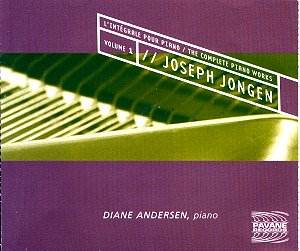I have long been a frustrated admirer of Jongenís
music. Although it has always been widely appreciated, it has
been too rarely heard and recorded in the many long years after
his death in 1953, of which 2003 marks the fiftieth anniversary.
Now, at long last, it is slowly being given its due, at least
as far as recordings are concerned. Performances in concert or
recital are still a rare event, even in Belgium. Things, however,
are now on the change and this rehabilitation should go on throughout
2003. At the very least Jongenís representation in the record
catalogue will be greatly improved by the end of the year.
His considerable output includes many piano works,
often substantial ones, of which a mere handful has remained in
the repertoire. The present double-CD set, actually the first
volume of Pavaneís recording of his complete piano music, is a
real eye- and ear-opener. It has often been taken for granted
that Jongen only composed short, impressionistic miniatures, such
as the popular Two Pieces Op.33 or the neo-classical
Sonatina Op.88. That he never composed a full-fledged
piano sonata seems to have ruled him out as a serious composer
of piano music. He nevertheless composed piano works throughout
his long career. He was a gifted pianist who regularly played
in concerts. During World War I, he settled in England and founded
the Quatuor belge de Londres with, among others, Lionel
Tertis. His first opus was a Concerto symphonique Op.1
for piano and orchestra composed in 1892 (he was nineteen!) and
his last piano work Mazurka Op.126 bis dates from
1943. However he went on writing several pieces for piano duet
until 1950. His pieces for piano duets and two pianos will also
soon be available in brand new recordings to be released shortly
by Pavane.
Jongenís natural lyricism is always counterbalanced
by formal clarity, harmonic subtlety, refined elegance and some
earthly directness inherited from his Ardennes origins. His musical
gifts are expressed in healthy, straightforward dance rhythms
redolent of folk song, although he rarely quotes folk material.
His piano music perfectly sums up Jongenís musical make-up and
ideals. These were, for him, articles of faith which he stuck
to regardless of fashion. This may account for the neglect into
which his music plummeted after his death. His music, as with
that of Moeran or Ireland, may be eclectic in its various influences
but, just as Moeranís or Irelandís, it is unmistakably personal.
The earliest work here is the reasonably popular
diptych Two Pieces Op.33 of 1908 (Clair de lune
and Soleil à midi) which made much for Jongenís
reputation in the early 20th Century. In spite of whiffs
from Debussy or Ravel, the music brilliantly demonstrates Jongenís
idiomatic grasp of the instrumentís possibilities. The Deux
rondes wallonnes Op.40 of 1912, which he also orchestrated
as he did the Two Pieces Op.33 and the Petite
Suite Op.75, have long been quite popular (probably more
so in their orchestral guise). Both are based on Walloon folk
songs and the second round rhapsodises on a well-known cramignon
from Liège. The cramignon is a round dance related
to the French carmagnole. Crépuscule au Lac
Ogwen Op.52 was composed during his stay in England, as
was his Danse lente Op.56 for flute and harp or
piano. The Op. 52 work is an atmospheric miniature of the kind
that Ireland or Moeran might have written. In fact, Jongenís piano
music has much in common with that of these composers. Though
he never composed a traditional "grand" piano sonata,
Jongen nevertheless came near to it when he composed one of his
first major piano works, the substantial Suite en forme
de sonate Op.60. This is a real sonata in all but name,
in spite of the somewhat misleading titles of the movements: Sonatine,
La neige sur les Fagnes [a region in eastern Belgium where
Jongen owned a summer cottage], Menuet dansé and
Rondeau. The opening Sonatine pays homage to Scarlatti,
whereas La neige sur les Fagnes is a beautifully atmospheric
reverie, of which the dreamy mood is soon dispelled by
the elegant Minuet. This major work ends with a lively Rondeau,
a joyful, energetic peasant dance. As so many works with a similar
title, Petite Suite Op.75, which also exists in
orchestral guise, is music for children. Nevertheless this is
quite demanding on the pianistís part. It is a suite of colourful
vignettes conjuring up childrenís games and dreams. It is one
of his most appealing works with more than a touch of delicate
humour. The Neo-classical Sonatina Op.88 is probably
his best-known piano work, or Ė at least Ė the one that has secured
a permanent place in the repertoire. Quite deservedly so for its
brevity encompasses all major Jongen hallmarks Ďin a nutshellí.
The three Impromptus, Op.87, Op.99
and Op.126 No.1 (the latter his penultimate piano
work) were written at various periods of Jongenís prolific composing
career. All three are free fantasies of almost improvisatory character
and of great melodic charm. The 24 petits préludes
dans tous les tons Op.116, composed during the war years
in 1940-1941, are short character studies of great variety, never
outstaying their welcome. They are in turn dreamy, playful, tender,
lightly dancing, paying passing homage to Chopin (No.17) and to
Scarlatti (No.22) or greeting his daughterís third birthday (No.9).
The whole set is capped by a lively and brilliant Toccata-fanfare
of great verve followed by a peaceful, song-like epilogue (No.24
Pour conclure). This is another major achievement far transcending
the implied didactic purpose its title might suggest.
Diane Andersenís richly varied tonal palette,
effortless technique and poetic insight are ideally suited to
Jongenís superbly crafted, subtly varied and appealing music.
This is a real must for any Jongen lover. I am eagerly awaiting
Volume 2 and the opportunity to hear more of his music.
Hubert Culot

![]() Diane Andersen (piano)
Diane Andersen (piano)![]() PAVANE ADW 7475/6
[70:29 + 76:56]
PAVANE ADW 7475/6
[70:29 + 76:56]